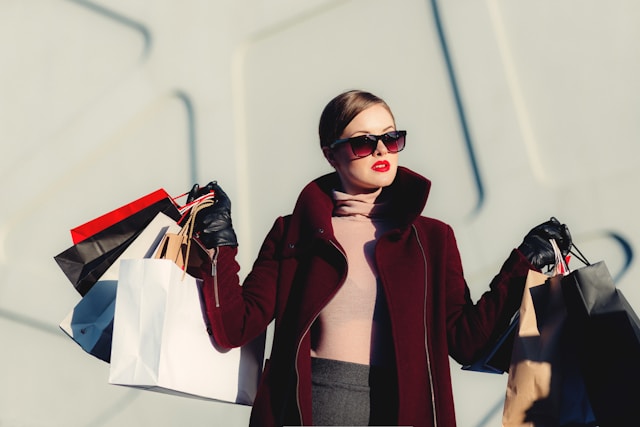Introduction
On Glam Observer, we never tire of emphasizing the vibrancy of the fashion world. Whether it’s about roles, brands, or trends, the landscape continually evolves. Today, let’s delve deep into the best fashion companies, where potential meets opportunity. From luxury houses to innovative startups, every turn in the fashion road is a potential career path. Let’s embark on this journey!
Categories of Interest
Type
Fashion brands can be broadly classified into two main categories: fast fashion and luxury. These distinctions encompass not only the products they offer but also the entire ethos and consumer experience.
- Fast Fashion: Fast fashion brands are known for their quick turnaround of trendy, affordable clothing. They produce new collections rapidly to keep up with the latest fashion trends. Examples include Zara, H&M, and Forever 21. Fast fashion has democratized fashion by making stylish clothing accessible to a wide audience.
- Luxury: Luxury fashion brands, on the other hand, focus on exclusivity, craftsmanship, and premium pricing. They often have a long history of haute couture and are revered for their timeless designs. Examples include Chanel, Gucci, and Louis Vuitton. Luxury brands set the bar for sophistication, quality, and prestige in the fashion world.
Scale
The scale of a fashion brand can vary significantly, influencing its reach, resources, and operational complexity.
- Emerging Brand: Emerging brands are relatively new to the market, often with a fresh and innovative approach. They may not have gained widespread recognition yet but show great potential. Emerging brands inject new energy and creativity into the industry.
- Startup: Startups are in their early stages of development, typically characterized by a smaller team and limited resources. They are working towards establishing a presence in the market. Startups often drive innovation and experiment with new business models.
- Conglomerate: Fashion conglomerates are vast organizations that own and manage multiple fashion brands under their umbrella. These conglomerates can include a mix of fast fashion and luxury brands, allowing them to diversify their market presence and portfolio.
Prominent examples of fashion conglomerates are OTB (Only The Brave) and PVH, which house renowned labels like Diesel, Tommy Hilfiger, and Calvin Klein. Conglomerates have the resources and infrastructure to support multiple brands and drive global expansion.
Target Audience
Fashion brands often cater to specific demographic groups based on gender and age, tailoring their products to meet distinct consumer needs.
- Womenswear: Brands specializing in womenswear focus on clothing, accessories, and footwear designed for women. They address the ever-evolving fashion preferences of women of all ages, from casual wear to formal attire.
- Menswear: Menswear brands create fashion collections exclusively for men, offering a wide range of clothing, from suits and dress shirts to casual wear and accessories.
- Childrenswear: Childrenswear brands cater to the youngest members of society, providing clothing, shoes, and accessories for infants, toddlers, and children. These brands ensure comfort and style for the next generation of fashion enthusiasts.
Specialty
Fashion brands often have a particular area of expertise, catering to specific styles or needs within the fashion ecosystem.
- Sportswear: Sportswear brands design clothing and accessories optimized for physical activity and sports. They blend fashion with functionality to meet the demands of athletes and active individuals, inspiring both performance and style.
- Couture: Couture brands are synonymous with high fashion and custom-made clothing. They create one-of-a-kind, handcrafted garments for discerning clients, showcasing the pinnacle of craftsmanship and creativity.
- Footwear: Footwear brands specialize in shoes, boots, and sandals, emphasizing comfort, style, and craftsmanship. Quality footwear is a cornerstone of fashion, enhancing both aesthetics and functionality.
- Accessories: Accessory brands produce a wide range of fashion items, including handbags, jewelry, scarves, and belts. These items complement clothing and complete a look, often serving as statement pieces that reflect personal style.
- Bridal: Bridal brands focus on creating wedding gowns, tuxedos, and attire for brides and grooms on their special day. These brands capture the essence of romance and elegance, ensuring that weddings are moments of timeless beauty.
Beyond Design: The Multifaceted Roles of Fashion Brands

Fashion brands play diverse roles beyond their primary design function. These roles are essential for their overall success and impact on the industry. Understanding these facets is crucial for a comprehensive view of the fashion world.
Legal & Finance
Fashion brands must navigate complex legal issues related to trademarks, copyrights, and contracts. Intellectual property protection is vital in an industry where design and branding are core assets. On the financial front, effective budgeting, profit analysis, and investment decisions are essential for sustaining operations and growth.
Digital Marketing & Social Media
In the digital age, fashion brands heavily rely on digital marketing strategies and social media presence to connect with their audience. They build brand awareness, engage with consumers, and drive sales through online platforms. Fashion brands must master the art of storytelling and visual communication to thrive in the digital landscape.
Supply Chain & Sustainability
Managing the supply chain efficiently is critical for fashion brands. It involves sourcing materials, overseeing production processes, and ensuring timely delivery to meet consumer demands. Additionally, sustainability has become a significant concern in the fashion industry. Brands are increasingly adopting eco-friendly practices, such as using sustainable materials, reducing waste, and promoting ethical labor practices.
HR & Client Experience
Human resources play a pivotal role in fashion brands by hiring and retaining talent. Creative designers, skilled artisans, marketing experts, and retail staff all contribute to the brand’s success. Additionally, ensuring an exceptional client experience is vital for brand loyalty and customer satisfaction. Fashion brands strive to create memorable shopping experiences and personalized services that resonate with their audience.
Luxury Brands: A Class Apart
Iconic Luxury Brands
Luxury brands are renowned for their exquisite craftsmanship, exclusivity, and timeless appeal. They are more than just clothing; they are symbols of prestige and sophistication. Some of the world’s most iconic luxury brands include:
- Louis Vuitton: Known for its monogram canvas and leather goods, Louis Vuitton has a rich heritage dating back to 1854. It epitomizes luxury travel and craftsmanship.
- Dior: Founded by Christian Dior in 1946, Dior is synonymous with haute couture and elegant fashion, with iconic designs like the “New Look.”
- Prada: Prada, an Italian fashion house, is celebrated for its minimalistic yet avant-garde designs and luxury accessories.
Major Luxury Conglomerates
Within the luxury fashion industry, major conglomerates have a significant presence, shaping the landscape of opulence and elegance. Let’s explore some of the major players:
- LVMH (Moët Hennessy Louis Vuitton): LVMH is a global powerhouse, home to several iconic luxury brands. It stands out for its emphasis on artistry, heritage, and innovation. Some of the brands under LVMH’s umbrella include:
| Brand | Description |
|---|---|
| Louis Vuitton | Known for its luxurious luggage and leather goods, Louis Vuitton is a symbol of French elegance and craftsmanship. |
| Dior | Dior’s couture creations are renowned for their timeless elegance and artistic flair. |
| Fendi | Fendi is known for its high-quality fur and leather products, as well as its ready-to-wear collections. |
| Givenchy | Givenchy offers a blend of classic and modern fashion, with a focus on elegance and sophistication. |
- Kering: Kering is another global luxury conglomerate with a different approach, emphasizing sustainability and innovation. Some of the notable brands in the Kering portfolio include:
| Brand | Description |
|---|---|
| Gucci | Gucci is a fashion powerhouse known for its bold designs, innovative campaigns, and a commitment to sustainability. |
| Saint Laurent | Saint Laurent is renowned for its sleek and edgy designs, epitomizing the rock ‘n’ roll chic aesthetic. |
| Balenciaga | Balenciaga pushes the boundaries of fashion with avant-garde designs and unconventional silhouettes. |
These conglomerates not only nurture their brands but also drive industry trends and innovations, making them pivotal players in the luxury fashion sector.
Fashion Magazines: Where Style Meets the Pen
Fashion magazines are an integral part of the fashion ecosystem, acting as both trendsetters and storytellers. They provide a platform for luxury brands to showcase their creations and connect with their audience. Let’s explore some prominent publishers and their iconic magazines:
Condé Nast
Condé Nast is a global media company known for its luxurious and influential publications. Some of its prominent fashion magazines include:
- Vogue: Vogue is the epitome of high-fashion editorial content, setting trends and featuring iconic celebrities and designers.
- Vanity Fair: Vanity Fair covers a wide range of topics, including fashion, entertainment, and culture, with a focus on luxury and style.
- GQ: GQ caters to the modern gentleman, offering style advice, grooming tips, and profiles of influential figures.
Hearst Magazines
Hearst Magazines is another major publisher in the fashion industry, known for its stylish and diverse fashion coverage. Some of its iconic titles include:
- Harper’s Bazaar: Harper’s Bazaar combines high-fashion photography with insightful articles, catering to a sophisticated audience.
- Elle: Elle is known for its fashion-forward content, featuring the latest trends, celebrity interviews, and beauty tips.
In today’s digital age, fashion blogs and online publications have gained prominence, providing alternative platforms for fashion enthusiasts and professionals. These platforms offer diverse roles, ranging from editorial positions to digital marketing and social media management.
Retail and Ecommerce: The Shopping Paradigm

The retail sector plays a pivotal role in bringing luxury fashion to consumers worldwide. Whether it’s the grandeur of traditional brick-and-mortar stores or the convenience of cutting-edge e-commerce platforms, retail offers a diverse range of experiences for both shoppers and industry professionals. Let’s explore some of the key destinations and platforms in the luxury retail landscape:
Brick-and-Mortar Destinations
- Harrods (London): Harrods is a legendary luxury department store in London, known for its opulent interiors and an extensive range of luxury brands. It offers a shopping experience like no other, complete with personal shopping services and exclusive product launches.
- Saks Fifth Avenue (New York City): Saks Fifth Avenue is an iconic luxury department store in New York City, known for its designer boutiques and upscale shopping experience.
- Galeries Lafayette (Paris): Located in the heart of Paris, Galeries Lafayette is a historic department store known for its stunning dome and curated selection of luxury fashion brands.
Luxury Ecommerce Platforms
- Farfetch: Farfetch is a leading global luxury fashion online platform that connects consumers with boutiques and designers worldwide. It offers a curated selection of luxury items, including clothing, accessories, and footwear.
- ASOS: ASOS is a prominent e-commerce giant that caters to a wide range of fashion enthusiasts. It offers a diverse selection of brands, making luxury fashion accessible to a broader audience.
Professionals in the retail sector are responsible for curating and presenting the world’s best fashion in unique settings, providing an immersive shopping experience that extends beyond the transaction itself.
PR Agencies: The Voice of Fashion
Public Relations (PR) agencies are the bridge between luxury brands and the media, playing a pivotal role in shaping brand narratives and public perception. Renowned PR agencies, such as Karla Otto and Purple PR, represent multiple brands and offer a dynamic workspace for communication and promotion.
Karla Otto
Karla Otto is a globally recognized PR agency that represents some of the most prestigious luxury brands in the fashion industry. Some of their notable clients include Chanel, Valentino, and Christian Louboutin. Their services encompass media relations, event management, and strategic brand positioning. They create buzz and generate excitement around brand launches and events.
Purple PR
Purple PR is another influential agency known for its work with luxury brands like Gucci, Versace, and Dolce & Gabbana. They specialize in brand strategy, influencer outreach, and creative campaigns. Purple PR’s expertise lies in crafting compelling narratives that resonate with the target audience, ensuring that luxury brands maintain their allure and relevance.
PR agencies are instrumental in orchestrating high-profile events, fashion shows, and collaborations, fostering strong relationships between brands and the media, and ensuring that the brand’s message is conveyed effectively to the public.
Trend Forecasting Agencies: Future’s Fashionistas
Anticipating fashion trends is a complex yet essential aspect of the luxury fashion industry. Trend forecasting agencies act as visionary guides, helping brands navigate the ever-evolving landscape of fashion preferences and consumer behavior. Let’s delve into some prominent trend forecasting agencies and their services:
WGSN (World’s Global Style Network)
WGSN is a renowned trend forecasting agency that serves a diverse range of clients, including H&M, Nike, L’Oréal, and Chanel. Their services include trend analysis, market insights, and consumer behavior research. They meticulously track global fashion trends, emerging color palettes, and design aesthetics to provide brands with actionable insights for product development and marketing strategies.
FashionSnoops
FashionSnoops is a trend intelligence platform used by brands like Zara, Calvin Klein, and Levi’s. They offer trend reports, color forecasting, and creative inspiration. FashionSnoops helps brands make informed decisions by predicting the styles, materials, and themes that will resonate with consumers in the future.
These trend forecasting agencies employ a combination of data analysis, creative vision, and industry expertise to help luxury brands stay ahead of the curve. By understanding upcoming trends and consumer preferences, brands can maintain their relevance and appeal in the ever-changing fashion landscape.
Conclusion
the fashion industry is a vibrant and multifaceted world that encompasses a wide range of categories, scales, and roles. From fast fashion to luxury brands, from startups to conglomerates, and from designing clothes to managing legal and financial aspects, the fashion industry offers diverse opportunities and challenges. Whether you’re interested in fashion as a career or simply intrigued by its dynamics, understanding these various aspects is crucial. The fashion world continues to evolve, offering something for everyone, from consumers to professionals, making it a truly captivating and ever-changing landscape.
For a more in-depth understanding, you might want to refer to this video.
FAQs
A: Absolutely! Startups often offer diverse roles and firsthand experience.
A: While specialization can be beneficial, a broad understanding of multiple domains is equally valuable, especially early in one’s career.
A: Yes, fashion is a multifaceted industry with roles in finance, logistics, marketing, and much more.







